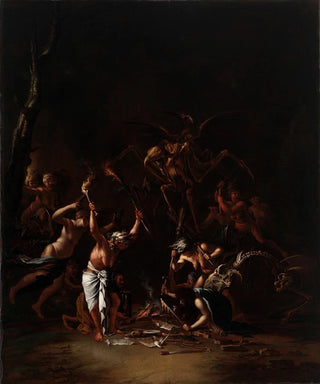Art print | The Witches' Sabbath - Salvator Rosa


View from behind

Frame (optional)
Art print The Witches' Sabbath - Salvator Rosa – Captivating Introduction
In the enchanting world of baroque art, "The Witches' Sabbath" by Salvator Rosa stands out for its evocative power and haunting atmosphere. This 17th-century masterpiece transports viewers to a realm where the fantastical and the real intertwine with rare intensity. Rosa, a master of light and shadow, manages to capture the very essence of witchcraft—a theme that both fascinates and frightens. The work, both dramatic and mysterious, invites reflection on human nature, power, and superstition, while revealing an exceptional talent for visual storytelling.
Style and uniqueness of the work
Salvator Rosa's style is characterized by a bold approach and mastery of contrasts. In "The Witches' Sabbath," he employs dark colors and deep shadows to create a gloomy ambiance, heightened by light illuminating certain faces, thus giving the scene an almost supernatural dimension. The human figures, with their tormented expressions and dynamic postures, seem to come alive under the artist's brush, while the richly detailed setting evokes a wild and mysterious landscape. This piece stands out for its blend of realism and imagination, where each element contributes to an atmosphere of tension and mystery. Rosa, using folkloric motifs and references to mythology, succeeds in creating a work that transcends its era, offering a unique vision of witchcraft and its psychological implications.
The artist and his influence
Salvator Rosa, born in 1615 in Naples, was a painter, poet, and playwright whose work profoundly influenced the artistic landscape of the 17th century. Influenced by Caravaggio and Renaissance masters, Rosa developed a personal style that combines baroque with romantic sensitivity. His interest in dark and fantastical themes, as well as his penchant for wild nature, made him an iconic figure of his time. Beyond his pictorial production, Rosa also influenced many later artists, notably through his innovative approach to the

Matte finish

View from behind

Frame (optional)
Art print The Witches' Sabbath - Salvator Rosa – Captivating Introduction
In the enchanting world of baroque art, "The Witches' Sabbath" by Salvator Rosa stands out for its evocative power and haunting atmosphere. This 17th-century masterpiece transports viewers to a realm where the fantastical and the real intertwine with rare intensity. Rosa, a master of light and shadow, manages to capture the very essence of witchcraft—a theme that both fascinates and frightens. The work, both dramatic and mysterious, invites reflection on human nature, power, and superstition, while revealing an exceptional talent for visual storytelling.
Style and uniqueness of the work
Salvator Rosa's style is characterized by a bold approach and mastery of contrasts. In "The Witches' Sabbath," he employs dark colors and deep shadows to create a gloomy ambiance, heightened by light illuminating certain faces, thus giving the scene an almost supernatural dimension. The human figures, with their tormented expressions and dynamic postures, seem to come alive under the artist's brush, while the richly detailed setting evokes a wild and mysterious landscape. This piece stands out for its blend of realism and imagination, where each element contributes to an atmosphere of tension and mystery. Rosa, using folkloric motifs and references to mythology, succeeds in creating a work that transcends its era, offering a unique vision of witchcraft and its psychological implications.
The artist and his influence
Salvator Rosa, born in 1615 in Naples, was a painter, poet, and playwright whose work profoundly influenced the artistic landscape of the 17th century. Influenced by Caravaggio and Renaissance masters, Rosa developed a personal style that combines baroque with romantic sensitivity. His interest in dark and fantastical themes, as well as his penchant for wild nature, made him an iconic figure of his time. Beyond his pictorial production, Rosa also influenced many later artists, notably through his innovative approach to the






